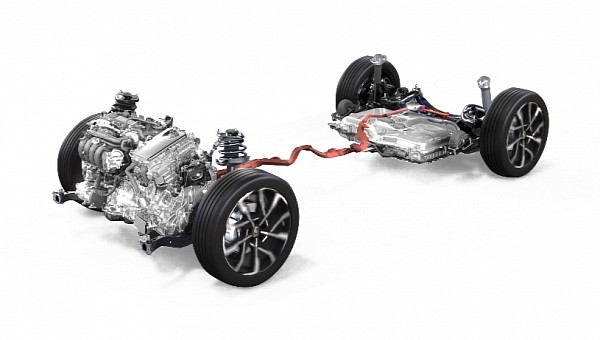Unveiled today, the fifth-generation Prius is a huge step forward in terms of exterior design. Toyota, as expected, also made significant efforts to improve the underpinnings, oily bits, and hybrid side of the powertrain.
First things first, Prius now rolls on the second-generation TNGA platform. TNGA stands for Toyota New Global Architecture. Introduced by the fourth-generation Prius in 2015 for the 2016 model year, the TNGA-C platform replaces the Toyota MC and New MC vehicle architectures.
Codenamed XW60 as opposed to XW50 for the outgoing model, the fifth generation features a lower center of gravity and larger-diameter tires thanks to the GA-C that underpins it. Additional reinforcements translate to improved rigidity and quietness. In terms of suspension technology, the Japanese automaker decided on MacPherson struts for the front axle and double wishbones for the rear. Toyota promises more stability in a straight line, more responsiveness in the twisties, and easier line-tracing ability.
No fewer than three powertrain options are offered, starting with two parallel-hybrid setups. The least powerful of the bunch is the 1.8-liter parallel hybrid, named as such because the internal combustion engine and electric side of the powertrain can both drive the vehicle individually in ICE or EV mode. Of course, they also come together for hybrid driving.
Over in Japan, the 1.8-liter setup develops up to 140 ps (138 hp). The 2.0-liter option cranks out 193 metric horsepower, which converts to 190 mechanical horsepower. E-Four AWD is featured, offering improved uphill performance on low-friction road surfaces and greater cornering stability than front-wheel-drive offers. The Japanese automaker hasn’t mentioned if the 1.8-liter standard hybrid spec can be optioned with the E-Four system.
Last, but certainly not least, the 2.0 can be upgraded from hybrid to plug-in hybrid. EV range has been extended by more than 50 percent compared to the outgoing model, which is called Prius Prime in the U.S. The plug-in hybrid also flaunts a roof-mounted solar charging system that generates power equivalent to driving up to 1,250 kilometers (777 miles) in a year.
The solar panels charge the drive battery when the vehicle is parked. They also provide electricity for the air conditioning system. The electricity these panels generate while driving is channeled to the auxiliary battery system. Capable of hitting 100 kilometers per hour (62 miles per hour) in 6.7 seconds, the plug-in hybrid belts out up to 223 ps (220 horsepower).
This combined output comes courtesy of a more powerful transaxle front motor, rated at 160 ps or 158 hp compared to 122 ps or 120 hp for the previous model. The combustion engine produces 148 ps (146 hp). The lithium-ion battery pack now features 13.6 kWh compared to 8.8 kWh.
Codenamed XW60 as opposed to XW50 for the outgoing model, the fifth generation features a lower center of gravity and larger-diameter tires thanks to the GA-C that underpins it. Additional reinforcements translate to improved rigidity and quietness. In terms of suspension technology, the Japanese automaker decided on MacPherson struts for the front axle and double wishbones for the rear. Toyota promises more stability in a straight line, more responsiveness in the twisties, and easier line-tracing ability.
No fewer than three powertrain options are offered, starting with two parallel-hybrid setups. The least powerful of the bunch is the 1.8-liter parallel hybrid, named as such because the internal combustion engine and electric side of the powertrain can both drive the vehicle individually in ICE or EV mode. Of course, they also come together for hybrid driving.
Over in Japan, the 1.8-liter setup develops up to 140 ps (138 hp). The 2.0-liter option cranks out 193 metric horsepower, which converts to 190 mechanical horsepower. E-Four AWD is featured, offering improved uphill performance on low-friction road surfaces and greater cornering stability than front-wheel-drive offers. The Japanese automaker hasn’t mentioned if the 1.8-liter standard hybrid spec can be optioned with the E-Four system.
Last, but certainly not least, the 2.0 can be upgraded from hybrid to plug-in hybrid. EV range has been extended by more than 50 percent compared to the outgoing model, which is called Prius Prime in the U.S. The plug-in hybrid also flaunts a roof-mounted solar charging system that generates power equivalent to driving up to 1,250 kilometers (777 miles) in a year.
The solar panels charge the drive battery when the vehicle is parked. They also provide electricity for the air conditioning system. The electricity these panels generate while driving is channeled to the auxiliary battery system. Capable of hitting 100 kilometers per hour (62 miles per hour) in 6.7 seconds, the plug-in hybrid belts out up to 223 ps (220 horsepower).
This combined output comes courtesy of a more powerful transaxle front motor, rated at 160 ps or 158 hp compared to 122 ps or 120 hp for the previous model. The combustion engine produces 148 ps (146 hp). The lithium-ion battery pack now features 13.6 kWh compared to 8.8 kWh.



























